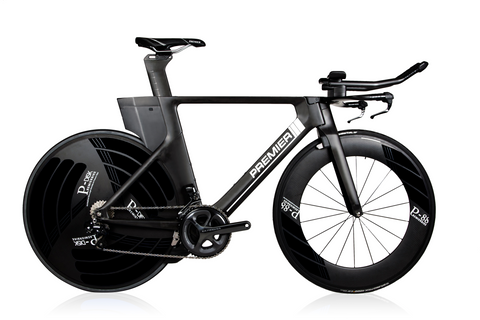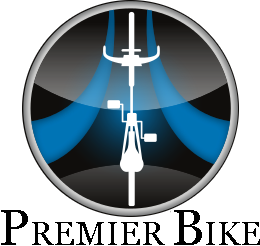Tactical Development

1. Development
2. Design
3. Delivery and Travel
4. Finite Element Analysis (FEA)
5. Comfort
6. Adjustability

DEVELOPMENT
Our development process began with a concept drawing followed by extensive CAD design, Finite Element Analysis (FEA) and Computational Fluid Dynamics (CFD). Finite element analysis (FEA) a computerized method for predicting how a product reacts to real-world forces, vibration and other physical effects is analyzed to show whether a product will break, wear out, or work the way it was designed. CFD allows our designers and engineers the ability to test frame and component designs in various simulated aero conditions. During the next step, ABS prototype samples were produced and refined. Wind tunnel testing and velodrome testing verified TACTICAL’s finished product performance. Tactical structural testing exceeds both US and International Standards.
"1.0-2.0" TACTICAL
DESIGN
PremierBikes’ approach to design analyzes the airflow that each of the components encounters to maximize the overall performance as a cohesive system; while taking rider comfort into consideration. If a rider cannot stay in an aero position for the duration of an event, the features of a super-bike cannot be fully realized. With that as the basis for design, every tube profile, aero-foil and junction has been engineered, developed and tested extensively to work together to minimize drag, control airflow and increase rider comfort across all relevant yaw angles. We did not constrain ourselves with UCI rules trying to serve two masters with one frame. This is a Triathlon bike!
AEROBAR
Our proprietary aero-bar, stem, extension tubes and elbow pads are designed as an integrated component of the overall bike. The extension tube mounting hardware is a “stacking design” to minimize frontal area. Care was taken to provide 100% internal routing for all brake and Shimano DI 2 shifter cables at the bullhorns and extensions. Special care was taken to design the most ergonomic extension tube shape possible to reduce forearm and wrist fatigue while providing an exceptionally strong fulcrum for up-hill climbing. In addition, the cockpit is very adjustable and the elbow pads, extension bars and elbow pad width can all be adjusted independently.

WHEEL FAIRING/Integrated 1X/BENTO BOX
Exploiting every advantage: when analyzing Computational Fluid Dynamic (CFD) data we determined that a small amount of drag could be saved if we extended the wheel well beyond the rear tire/brake track interface. Keeping the air attached while exiting the seat tube consistently improved the overall CFD drag numbers. We took a chance and designed around this difference and it paid off in the wind tunnel. We then re-designed the bottom portion of the rear storage to match the flow as well as the BB brake fairing; maximizing the savings - resulting in an elegant solution to drag reduction.
Many athletes want the option to run a 1X drivetrain. For us that is not an afterthought - we include an alloy insert to smooth the frame rather than leaving an aero snag point like our competitors frames.
Two standard bosses are integrated into the top tube in the event one would like to add a bento box.

WHEELS/TIRES
All Tactical bikes ship with our wide rear Disk and front 88 mm Deep Carbon Wheel made from Toray T800 High Modulus Carbon fiber. These high impact resistant wheels increase both strength and braking performance. Our 11 speed compatible 24 mm wide Disk - for long haul top performance and an 88 mm deep 25 mm wide front wheel are matched with race tires.


REAR STORAGE/BOTTLE CAGE
Our optimized rear storage box is specifically designed to work with PremierBikes’ "1.0-2.0" Tactical. The rear storage slightly reduces drag depending on the yaw angle tested. The rear storage box does not increase any measurable drag at any yaw angle tested. The storage box mounts with two standard water bottle screws. The rear storage is small by design but will hold a spare tube, 2 CO2, tire tool, patches and multi-tool. If you prefer, the screw holds can be used for a rear bottle holder.

FORK
A bikes fork is an important and integral part of the bike, but it's difficult to define what makes various forks different, what's marketing fluff, and how a fork can completely change the geometry and handling of a bike. Our Trail-Shift Insert makes it possible to alter the ride feel by increasing the Front Center up to 3.24 mm. It also allows for riders that purchase a SM, MD or LG bike at any extreme of the fit parameters: to maximize ride feel. Adjust shorter for a more interactive feel or longer for a more stable feel (think long downhill courses). The front center pull brake is integrated behind the fork and is covered with an aero cover that further reduces frontal drag.

"1.0-2.0" TACTICAL
Delivery and Travel:
If you choose the option, the Tactical bike is shipped to you in our triathlon specific Smart Safety Travel Case. Our travel case, made from ABSPC is the lightest, toughest and best way to protect your bike when shipping it by ground or air. The interior is fully padded for extra protection. The case includes wheel covers and high-density foam. Straps secure the frame. The saddle, seat post and pedals go in a protective bag. There is plenty of space to fit clothing, shoes, helmet, tools and track pump. The case is a clamshell design complete with combination and TSA lock. But that was not enough: Newer competitors bikes are a pain to take apart and re-assemble during travel. No problem with our bike or our case. There is no need to remove the base bar, stem or cables. Simply loosen the extension tubes by removing the two bottom screws and strap the extension tubes to the top tube. That’s it! The case also holds three wheels; a rear disk and dedicated space for two front wheels so you don’t have to guess what wind conditions will be.
"1.0-2.0" TACTICAL
Finite Element Analysis (FEA)
Finite element analysis (FEA) a computerized method for predicting how a product reacts to real-world forces, vibration and other physical effects is analyzed to show whether a product will break, wear out, or work the way it was designed. In addition to analyzing individual junctions, tubes and tube walls we used FEA to look at four (4) main tests. In the first phase we test the dynamics of pedaling force. In addition, we simulate all the forces that the human body can exert on the frame, aerobar, seat tube and fork. After completion of the first phase we do the three important crash simulation tests as determined by European and US safety standards.
1. Aerobar strength - Force (125 LB per side) is applied to both sides of the aerobar to test its' strength and deflection. In the final design, aluminum tubes have been inserted and bonded into the bullhorn ends to further strengthen that area.
2. This test simulates a crash into a ditch - we insert a hinged steel rod into the seat tube with 70 KG plates to simulate the riders weight. We secure the frame into a stand with the rear drop-outs to allow the frame to pivot. We then raise the frame at a 45 degree angle and allow the frame to fall forward which simulates crashing into a ditch. What we are monitoring is the deflection near the frame/seat tube interface as well as the fork. This tests put far greater forces on the frame than a real world crash where some force will be absorbed buy the tires rims and spokes.
3. This test simulates a frontal crash at medium speed. We raise the frame vertically with the fork attached and secure it with the rear dropouts. We insert a 22.5 KG weight with a roller in place of the front hub. Here we found great absorption capacity of our fork buffering the frame from the impact.
4. This test puts a hard impact on the fork to simulate a hard crash at high speed. The fork is completely secured in a fixture to verify how the fork acts independently from the frame. This test is done two times and the fork must maintain its' complete integrity. Our fork deflection was approximately 1 mm showing its' ability to uniformly distribute external forces throughout its structure.
"1.0-2.0" TACTICAL
COMFORT
The grueling distance of triathlon competition requires riders to balance aerodynamic performance with comfort. The "1.0-2.0" TACTICAL features excellent geometry and functionality for triathletes to help riders achieve their ideal fit. Wide 24 mm Rear Disk allow for up to 26 mm rear tire resulting in long haul comfort without aero penalty. Along with refined frame geometry, the "1.0-2.0" TACTICAL cockpit features a wide range of adjustability. The ergonomic extension tube shape reduces forearm and wrist fatigue.
ADJUSTMENT RANGE
In addition to refined frame geometry, we provide for a wide range of adjustability while simplifying the cockpit configuration to fit riders more easily.
BASE BAR
"1.0-2.0" TACTICAL’s proprietary base bar features a triathlon-specific fully integrated airfoil design. The bar is 42 cm wide
TRAIL-SHIFT
With our innovative Trail-Shift feature the wheel base and rake can be adjusted up to 3.24 mm to change the feel of the ride.
ELBOW PADS
"1.0-2.0" TACTICAL’s elbow pads are adjustable from 0 to 60 millimeters of stack height using aero designed spacers. (5mm increments)
Elbow Pads feature a wide range of fore/aft, adjustment and are adjusted independent of the extension tubes.
- Pad Reach adjustment range 165 mm (center to center)
EXTENSIONS
"1.0-2.0" TACTICAL’s carbon extensions feature wide fore and aft adjustment independent of the elbow pads. The tubes are 358 mm in length.
Quality Manufacturing…Intelligent Design…. Reasonable Prices…
built for you.












